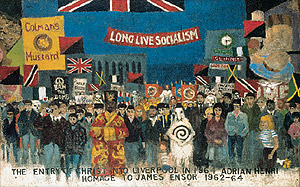
| HOME |
| NERVE |
| REVIEWS |
| ARCHIVE |
| EVENTS |
| LINKS |
| ABOUT US |
| CONTRIBUTORS |
| BACK ISSUES |
| CONTACT US |
 Centre
of the Creative Universe: Liverpool and the Avant-Garde
Centre
of the Creative Universe: Liverpool and the Avant-Garde
Tate Liverpool (20th February - 9th September 2007)
Reviewed by Jennie Lewis
Renowned for celebrating our city of Liverpool, the Tate’s current exhibition ‘Liverpool and the Avant-Garde’ fails to disappoint its host of anticipators. Coinciding with the city’s 800th anniversary celebrations, this exhibition depicts the movement in art and culture in Liverpool, decade by decade, from the 1960s onwards.
Homage is paid to the infinitely famous L8 residents. through an encapsulating photography collection by Max Scheler and Astrid Kirchherr, indicating the vital role Liverpool played in the 1960s global pop revolution, capturing the excitement and vibrancy of the area from where the famous Beatles emerged.
Alongside artwork charting the city’s rise in the world of music, it is also revealed how Liverpool has, throughout the years, been host to an array of avant-garde movements from Beat to conceptual art, signifying a more bohemian and creative spirit. Ginsberg himself even visited our hometown, and revelled with us in its thriving cultural core.
Quite aside from commemorating the city’s iconic figures, much of the artwork on show portrays everyday Liverpool, in an unfeigned though unbiased manner. The lucid eye of photojournalist Henri Cartier-Bresson offers an account of workaday 1960s Liverpool, highlighting issues of class and civic order. However, such realism is somewhat romanticised through the work of Edward Chambre-Hardman, who, through his own unique pictorial style portrays a city re-inventing itself lending it some poetic grandeur.
Perhaps one of the most poignant collections throughout the exhibition is the Herculaneum Dock Series by the Boyle Family. Their sculptures border on being brutally honest, signifying, through words of their own, “memories of places where we suffered joy and anguish or tenderness and laughter. We want to see without motive or reminiscence.”
Moving into the 1980s and 1990s, artists confront more political issues, such as heightened sexual liberation through the growing club scene, and growing cultural and racial discord. Vanley Burke, who moved to the city from Jamaica during the eighties, constitutes a record of circumstances absent from mainstream perceptions of the city through his often uncompromising images, underpinning a once reasoned concern.
Neville Gabie speaks volumes with his collection, entitled 'Playing Away', consisting of painted goalposts throughout various areas of Liverpool. He says of his work, “With minimal means, these goalposts eloquently expressed much of what I was trying to achieve through making sculpture. They encapsulate our dreams and fantasies, and the uniqueness of ‘place’ in a language which is universally understood.” His adept ability to take an everyday image and inject such meaning is inspiring.
Overall, the exhibition reflects the truth of the past, the pride of the present, and the hope for the future of Liverpool. It is difficult to come away from the exhibition without feelings of immense pride for our city and all that it has to offer.